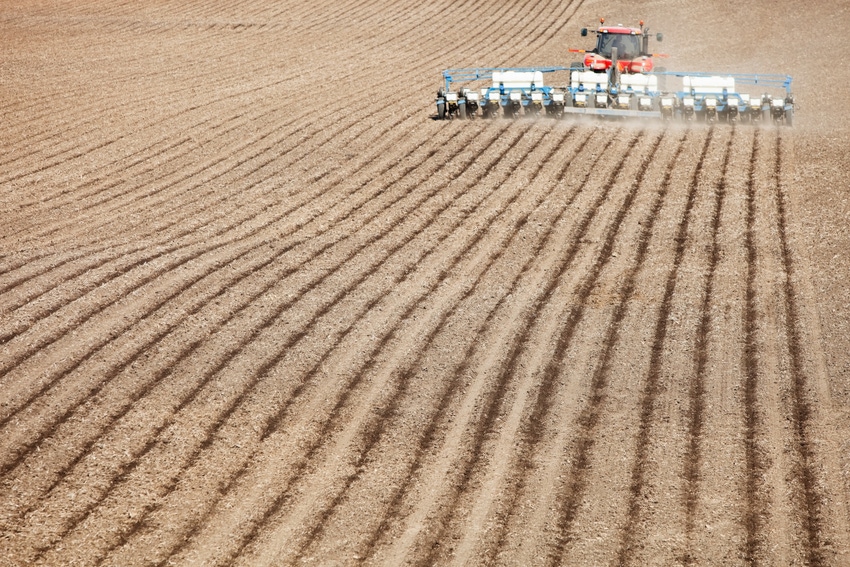May 3, 2019

We have equipment that can allow for many acres to be planted in a short time. And, we have the ability to mess up a lot of acres in a short time. The following are research-based tips for consideration.
Proper soil conditions
Compaction can occur from driving on or tilling in wet soils, creating clods and hard pans. Sidewall compaction can occur when injecting fertilizer or planting seed into wet soils when it’s being “mudded in.”
Planting in wet conditions leads to the temptation of planting shallow which can lead to additional problems.
Plant into soil temps as close to 50°F as possible. Check weather conditions for the next 48 hours to see if temperatures are expected to be 50°F or higher, and avoid saturated soil conditions. If planting a few degrees less than 50°F, make sure to check with seed dealers on more cold-tolerant seed, and only plant if the forecast is calling for warm temperatures the next few days that would also help increase the soil temperature. Once planted, corn seeds need a 48-hour window and soybean seeds need at least a 24-hour window when the soil temperature at planting depth does not drop much below 50°F
Proper planting window vs. calendar date
Weather conditions vary from year to year, thus calendar dates aren’t as important as planting windows for optimum corn yield in Nebraska. Not every year will the optimum planting date for corn be in April. This has also been found throughout the Corn Belt.
Planting soybean early is critical to maximizing yield. This has been found through numerous university studies in addition to grower-reported data. Because of this, an increasing number of growers are planting soybean earlier than or at least at the same time as planting corn. We do recommend using a fungicide seed treatment when planting soybean in late April/early May, as we don’t have research without it.
Proper planting depth
Aim to get corn and soybean in the ground 1.5-2 inches deep. Planting 1.5-2 inches deep keeps corn and soybean seed in even soil temperature and moisture conditions.
For corn, proper depth is critical for root establishment and avoiding rootless corn syndrome where the nodal (crown roots) don’t get well established.
While soybean is more forgiving on planting depth, UNL research found lowest yields when soybean was planted 1.25 inches deep or less or 2.25 inches or greater with the highest yield at 1.75 inches deep.
Get out and check. Even with monitors showing down force and seeding depth, it’s still important to check what actually is happening. It’s also important to do this for all planter units within every field, particularly with different tillage/residue situations. We’ve seen how adjusting down force can lift up planter ends, resulting in shallow planting in the outside rows, particularly with center-fill planters. Results of improper/uneven planting depth can be seen all season long and may affect yields. While in-field checks take time, you’ll be glad you caught any issues before too many acres are planted incorrectly.
Proper seeding rates
In general, our research has shown a trend of yield increases with increasing corn populations; however, it is very hybrid dependent. We’d recommend working with your seed dealer or testing different seeding rates via on-farm research.
In soybean, 12 years of Nebraska research have shown seeding rates can be reduced without significantly affecting yields. This has been found for both 15-inch and 30-inch planted rows in medium- to fine-textured soils in eastern and western Nebraska. Our recommendation based on the research is to plant 120,000 seeds/acre and aim for a final plant stand of 100,000 plants/acre. Reducing rates from 150K to 120K can save a grower $10/acre depending on seed costs.
Planting does set the stage for the remainder of the year! This year, we’ve already seen and heard reports of how mudding in fertilizer or seed is impacting germination due to compaction and seed vees not closing. Agronomically and economically it’s important to do this right the first time.
If you’re interested in testing any of these considerations for yourself, a number of on-farm research protocols are available for various production practices or products. You can view them all online.
Source: University of Nebraska
The source is solely responsible for the information provided and is wholly owned by the source. Informa Business Media and all its subsidiaries are not responsible for any of the content contained in this information asset.
You May Also Like




